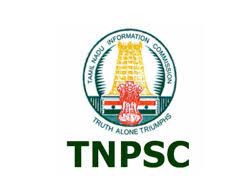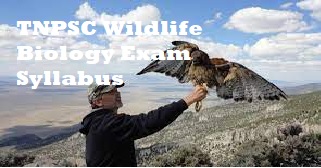TNPSC Wildlife Biology Exam Syllabus : Tamil Nadu Public Service Commission
Organisation : Tamil Nadu Public Service Commission (TNPSC)
Exam Name : TNPSC Wildlife Biology Examination
Standard : PG Degree Standard
Code : 271
Announcement : TNPSC Wildlife Biology Exam Syllabus
Website : https://www.tnpsc.gov.in/English/new_syllabus.html
TNPSC Wildlife Biology Exam Syllabus
UNIT – I: WILDLIFE OF INDIA
Definition of Wildlife: Causes of wildlife depletion; Economic importance of wildlife; need for wildlife conservation; Taxonomy & Identifying Characters of Fishes, Amphibians, Reptiles, Birds (up to orders) and mammals (upto family) with examples; rare, endangered, threatened and endemic species of fishes, amphibians, reptiles, birds and mammals in India- India as a mega wildlife diversity country.
Related / Similar Syllabus : TNPSC Anthropology Exam Syllabus

UNIT – II: FORESTRY AND SILVICULTURE
Forest types in India – identification, dendrology; Deforestation & Impacts; Forest Inventory; Natural and artificial regeneration of forests; nursery techniques; seed – technology: Collection, storage, pretreatment and germination, establishment and tendings; Silviculture systems: Clear felling, uniform, shelter – selection, Coppice and conversion system silviculture of economically important species of India- Pinus roxlurghil, Acacia spp., Dalbergia spp., Tectona grandis, Terminalia spp.; Tree improvement & Seed Technology; Non timber forest products; Wood seasoning and preservation; Forest Mensuration: diameter, girth, height and volume of trees, form – factor, volume estimation of stand; Sampling methods and sample plots; Yield calculation; Forest survey – map reading; Watershed management; Establishment of
herbaria and arboreta. Agro forestry systems – Social/Urban Forestry – Joint Forest Management – General forest protection against fire, insects, pests and diseases;
Indian Council of Forestry Research and Education; Indian Forest Act 1927, Forest Conservation Act 1980.
UNIT – III: FOREST ENTOMOLOGY
Insect damage based on mode of attack- Leaf eater, Sap sucker, Meristematic tissue
feeder, Wood destroyer- Harmful Insects and their role in forest economy: Insect pests of important trees of India -Teak, Sal and Bamboo; Role of locusts and termites in forest economy; Beneficial Insects and their role in forest economy: Scavenger insects- dung beetles; Pollinators, Predatory insects, and parasitic insects on insect pests; Assessment of insect damage and control measures: Survey and estimation of insect abundance – devices for evaluation- methods of determining damage – biological evaluation; control of forest insects- direct and indirect methods – microbial insecticides and modern approaches.
UNIT – IV: ETHOLOGY OF WILDLIFE
Instinctive behaviour-classical and modern concepts-fixed action pattern and ritualization; Learning-Imprinting-habituation. Analysis of behaviour pattern – taxis, kinesis and reflexes; Methods of studying animal behavior; Biological rhythms and bird migration; Types of animal communications; Optimal Foraging behaviour; Origin and significance of play; Courtship, display, sexual selection and parental care in mammals and birds; Social behaviour of elephants and lion.
UNIT – V: WILDLIFE MANAGEMENT TECHNIQUES
Vegetative analyses – Point Centered Quadrat, Quadrat, Strip transect; GIS and Remote sensing in wildlife habitat surveys-Habitat manipulation: food, water, shade improvement; impact and removal of invasive alien species; Making observations and records: field notes & datasheets; Planning wildlife management Investigations and projects; Wildlife Photography: types of cameras, camera traps; Field Equipments: binoculars, altimeter, pedometer, field compass. Sound recording & Media players; activity recording; weight measurement; Radio isotopes; radio collaring; GPS; GIS; Remote sensing: Satellite images, Drones and their applications in wildlife management.

UNIT – VI: WILDLIFE CENSUS METHODS
Planning census – total counts – sample counts – Basic concepts and applications – Direct count (block count, transect methods, Point counts, visual encounter survey, waterhole survey); Indirect count (Call count, track and signs, pellet count, pugmark, camera trap, DNA finger printing and aerial photography) – Identifying animals based on indirect signs – Capture – Recapture techniques – Capturing and marking techniques: Live trapping of birds and mammals – Chemical immobilization; Methods of marking wild animals – Ringing- Tagging – Clipping – Colouring; Capture and recapture indexes.
Download Syllabus
Download Syllabus Link: http://www.syllabus.gen.in/uploads/pdf2022/2846-syllabus.pdf